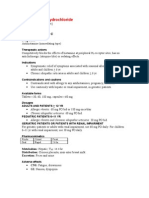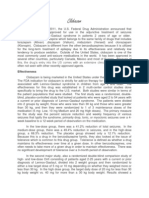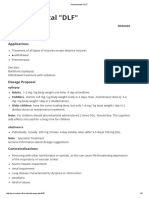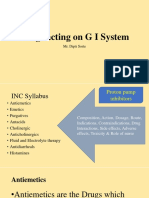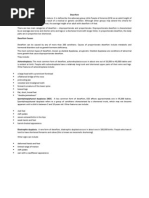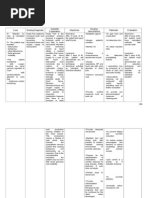Drug Name Mechanism of Action Indications Contraindications Adverse Effect Nursing Considerations
Drug Name Mechanism of Action Indications Contraindications Adverse Effect Nursing Considerations
Uploaded by
Katrina PonceCopyright:
Available Formats
Drug Name Mechanism of Action Indications Contraindications Adverse Effect Nursing Considerations
Drug Name Mechanism of Action Indications Contraindications Adverse Effect Nursing Considerations
Uploaded by
Katrina PonceOriginal Description:
Original Title
Copyright
Available Formats
Share this document
Did you find this document useful?
Is this content inappropriate?
Copyright:
Available Formats
Drug Name Mechanism of Action Indications Contraindications Adverse Effect Nursing Considerations
Drug Name Mechanism of Action Indications Contraindications Adverse Effect Nursing Considerations
Uploaded by
Katrina PonceCopyright:
Available Formats
Drug Name Generic name: Salbutamol
Mechanism of Action
Indications To control and prevent reversible airway obstruction caused by asthma or chronic obstructive pulmonary disorder (COPD) Quick relief for bronchospasm For the prevention of exercise-induced bronchospasm Long-term control agent for patients with chronic or persistent bronchospasm
Contraindications
Adverse Effect Nervousness Restlessness Tremor Headache Insomnia Chest pain Palpitations Angina Arrhythmias Hypertension Nausea and vomiting Hyperglycemia Hypokalemia
Nursing Considerations
Brand name: Alrovent
Route: Inhalation
Dosage: 2.5 ml
Frequency: q 12 hours
Classification Bronchodilator (therapeutic); adrenergics (pharmacologic)
It relieves nasal congestion and reversible bronchospasm by relaxing the smooth muscles of the bronchioles. The relief from nasal congestion and bronchospasm is made possible by the following mechanism that takes place when Salbutamol is administered. First, it binds to the beta2-adrenergic receptors in the airway of the smooth muscle which then leads to the activation of the adenyl cyclase and increased levels of cyclic- 35adenosine monophosphate (cAMP). When cAMP increases, kinases are activated. Kinases inhibit the phosphorylation of
Hypersensitivity to adrenergic amines Hypersensitivity to fluorocarbons
1. Assess lung sounds, PR and BP before drug administration and during peak of medication. 2. Observe fore paradoxical spasm and withhold medication and notify physician if condition occurs.
3. Administer PO medications with meals to minimize gastric irritation. 4. Extended-release tablet should be swallowedwhole. It should not be crushed or chewed. 5. If administering medication through inhalation, allow at least 1 minute between inhalation of aerosol
myosin and decrease intracellular calcium. Decreased in intracellular calcium will result to the relaxation of the smooth muscle airways.
medication. 6. Advise the patient to rinse mouth with water after each inhalation to minimize dry mouth. 7. Inform the patient that Albuterol may cause an unusual or bad taste.
You might also like
- Chymoral PlusDocument3 pagesChymoral PlusNeha SureshNo ratings yet
- Formoterol FumarateDocument3 pagesFormoterol Fumarateapi-3797941100% (1)
- EstradiolDocument5 pagesEstradiolkitsilcNo ratings yet
- Asthalin InhalerDocument7 pagesAsthalin InhalerINDAH WIDYANING TYASNo ratings yet
- Product Information Avil Product NamesDocument4 pagesProduct Information Avil Product Namesindyanexpress100% (1)
- Serratiopeptidase Is An Enzyme Having AntiDocument12 pagesSerratiopeptidase Is An Enzyme Having Antidracula386No ratings yet
- Case Pre Drug StudyDocument5 pagesCase Pre Drug StudyJoule PeirreNo ratings yet
- Amoxicillin Drug StudyDocument2 pagesAmoxicillin Drug StudyDUMANGENG ELLAINE D.No ratings yet
- HaemaccelinfDocument9 pagesHaemaccelinfSisca YulistianaNo ratings yet
- Fexofenadine Hydro ChlorideDocument2 pagesFexofenadine Hydro Chlorideapi-3797941No ratings yet
- Q-MED ADRENALINE INJECTION 1 MG - 1 ML PDFDocument2 pagesQ-MED ADRENALINE INJECTION 1 MG - 1 ML PDFchannalingeshaNo ratings yet
- DrugsDocument10 pagesDrugsRebecca JolieNo ratings yet
- StreptokinaseDocument18 pagesStreptokinasedickyNo ratings yet
- AdrenalineDocument2 pagesAdrenalinerazvan032006100% (1)
- Lasilactone PI 201801Document9 pagesLasilactone PI 201801Shivam GuptaNo ratings yet
- Brand Name: Chloromycetin Generic Name: Chloramphenicol Indication: External Ear CanalDocument2 pagesBrand Name: Chloromycetin Generic Name: Chloramphenicol Indication: External Ear CanalianecunarNo ratings yet
- AdrenalineDocument11 pagesAdrenalineAli AkhtarNo ratings yet
- 1 AcetazolamideDocument2 pages1 AcetazolamideKatrina PonceNo ratings yet
- DextroseDocument1 pageDextroseAdrianne BazoNo ratings yet
- KetoconazoleDocument2 pagesKetoconazolenatinlalaNo ratings yet
- EPOPROSTENOLDocument6 pagesEPOPROSTENOLMavy CantonNo ratings yet
- GanciclovirDocument3 pagesGanciclovirRosher Deliman JanoyanNo ratings yet
- MetherginDocument2 pagesMetherginOtan Cuison100% (1)
- PropanolDocument8 pagesPropanolStacey CamilleNo ratings yet
- College of Nursing: Brand Name: Cardizem Generic Name: Diltiazem Drug Classification: Calcium Channel BlockersDocument2 pagesCollege of Nursing: Brand Name: Cardizem Generic Name: Diltiazem Drug Classification: Calcium Channel BlockersChristine Pialan SalimbagatNo ratings yet
- NitroglycerinDocument5 pagesNitroglycerinapi-3797941100% (1)
- Drug Study AripiprazoleDocument3 pagesDrug Study AripiprazoleLEA MAE POSUGACNo ratings yet
- CLobazamDocument7 pagesCLobazamnika0126No ratings yet
- Ditropan Drug CardDocument2 pagesDitropan Drug CardBenNo ratings yet
- Mitomycin - UsmanDocument3 pagesMitomycin - UsmanSittie Nashieva A. UsmanNo ratings yet
- Phenobarbital - DLF1 - PDFDocument5 pagesPhenobarbital - DLF1 - PDFMJANo ratings yet
- Paracetamol - DSDocument3 pagesParacetamol - DSEnoch LabianoNo ratings yet
- Drug Study: NCM 106 Pharmacology: Patient MonitoringDocument2 pagesDrug Study: NCM 106 Pharmacology: Patient Monitoringpoleene de leonNo ratings yet
- Noradrenaline (Norepinephrine) : 1mg/mLDocument5 pagesNoradrenaline (Norepinephrine) : 1mg/mLBrian RelsonNo ratings yet
- Arterial PunctureDocument14 pagesArterial PunctureGstayu WidiastutiNo ratings yet
- Albendazol PDFDocument8 pagesAlbendazol PDFDANIBATANo ratings yet
- CaspofunginDocument2 pagesCaspofunginSapna thakurNo ratings yet
- Drugs Acting On G I System: Mr. Dipti SorteDocument65 pagesDrugs Acting On G I System: Mr. Dipti Sortesandeepv08No ratings yet
- Drug Study On Gastrointestinal AgentsDocument18 pagesDrug Study On Gastrointestinal AgentsJenica ManuntagNo ratings yet
- RifampicinDocument2 pagesRifampicinChaeL90No ratings yet
- NitroglycerinDocument3 pagesNitroglycerinFreisanChenMandumotanNo ratings yet
- BleomycinDocument3 pagesBleomycinVin Bitz100% (1)
- Drug Study DiazepamDocument2 pagesDrug Study DiazepamBunnie AlphaNo ratings yet
- Drug StudyDocument32 pagesDrug StudyKeepItSecretNo ratings yet
- Drug Study - AmoxicillinDocument2 pagesDrug Study - AmoxicillinVANESSA PAULA ALGADORNo ratings yet
- Drug Study On EPINEPHRINEDocument6 pagesDrug Study On EPINEPHRINEshadow gonzalezNo ratings yet
- MinoxidilDocument2 pagesMinoxidilHenna AhmedNo ratings yet
- Furosemide ChlorthalidoneDocument5 pagesFurosemide ChlorthalidoneLIEZEL GRACE VELAYONo ratings yet
- Depot-Ped: 3 Months: 11.25 MG or 30 MG Q12weeks. (SQ) Lupron: Children: Initially, 50Document3 pagesDepot-Ped: 3 Months: 11.25 MG or 30 MG Q12weeks. (SQ) Lupron: Children: Initially, 50thuey epeNo ratings yet
- Drug Study - CaseDocument9 pagesDrug Study - CaseMay EvelynNo ratings yet
- BretyliumDocument4 pagesBretyliumButchay LumbabNo ratings yet
- Generic Name: VORICONAZOLE Brand Name: Vfend Classification: Azole Antifungal Dosage/frequency and RouteDocument26 pagesGeneric Name: VORICONAZOLE Brand Name: Vfend Classification: Azole Antifungal Dosage/frequency and Routeanne marieNo ratings yet
- Tamsulosin - Drug Information - UpToDateDocument23 pagesTamsulosin - Drug Information - UpToDateGénesis GabrielaNo ratings yet
- OxaliplatinDocument10 pagesOxaliplatinlum_albertNo ratings yet
- Drug Study - CefpodoximeDocument4 pagesDrug Study - CefpodoximeIzza DeloriaNo ratings yet
- The Ride of Your Life: What I Learned about God, Love, and Adventure by Teaching My Son to Ride a BikeFrom EverandThe Ride of Your Life: What I Learned about God, Love, and Adventure by Teaching My Son to Ride a BikeRating: 4.5 out of 5 stars4.5/5 (2)
- SalbutamolDocument2 pagesSalbutamolMarck Vincent Garcia OngNo ratings yet
- Drug Study Ssalbutamol7Document3 pagesDrug Study Ssalbutamol7Gorgeouschelle FeriaNo ratings yet
- Sal But AmolDocument2 pagesSal But AmolKay MirandaNo ratings yet
- MEDICATION: Generic: Albuterol Trade: Accuneb: F and E: Hypokalemia Neuro: TremorDocument2 pagesMEDICATION: Generic: Albuterol Trade: Accuneb: F and E: Hypokalemia Neuro: TremorDelmNo ratings yet
- Patient S AssignmentDocument1 pagePatient S AssignmentKatrina PonceNo ratings yet
- Cues Nursing Diagnosis Scientific Reason Planning Intervention Rationale EvaluationDocument6 pagesCues Nursing Diagnosis Scientific Reason Planning Intervention Rationale EvaluationKatrina Ponce86% (7)
- ThyroidectomyDocument64 pagesThyroidectomyKatrina PonceNo ratings yet
- Different Types of Oxygen MasksDocument2 pagesDifferent Types of Oxygen MasksKatrina PonceNo ratings yet
- Nursing Management of The Perioperative PatientDocument19 pagesNursing Management of The Perioperative PatientKatrina Ponce100% (4)
- Caldwell LucDocument1 pageCaldwell LucKatrina PonceNo ratings yet
- GIT DisordersDocument171 pagesGIT DisordersKatrina PonceNo ratings yet
- DwarfismDocument2 pagesDwarfismKatrina PonceNo ratings yet
- Operating Room Equipments and Machineries: By: RICACHO, Ma. Norilyn BSN4B - Group8Document38 pagesOperating Room Equipments and Machineries: By: RICACHO, Ma. Norilyn BSN4B - Group8Katrina PonceNo ratings yet
- Safe SuctioningDocument31 pagesSafe SuctioningKatrina Ponce100% (2)
- Different Types of Oxygen MasksDocument2 pagesDifferent Types of Oxygen MasksKatrina PonceNo ratings yet
- Operating Room TeamDocument18 pagesOperating Room TeamKatrina PonceNo ratings yet
- Defense MechanismDocument2 pagesDefense MechanismKatrina PonceNo ratings yet
- Principles of Patient Skin PreparationDocument26 pagesPrinciples of Patient Skin PreparationKatrina Ponce100% (1)
- Pathophysiology of Closed Displacement Segmental FemurDocument1 pagePathophysiology of Closed Displacement Segmental FemurKatrina PonceNo ratings yet
- Prepared By: Hernandez, Dionne Cedric P. BSN4B Group 8Document24 pagesPrepared By: Hernandez, Dionne Cedric P. BSN4B Group 8Katrina PonceNo ratings yet
- NE2.1 Ward RoutinesDocument3 pagesNE2.1 Ward RoutinesKatrina PonceNo ratings yet
- "Acute Coronary Syndrome Non ST Elevation Myocardial Infarction Hypertensive Cardiovascular Disease Diabetes Mellitus Type 2 and Community AcquiredDocument21 pages"Acute Coronary Syndrome Non ST Elevation Myocardial Infarction Hypertensive Cardiovascular Disease Diabetes Mellitus Type 2 and Community AcquiredKatrina PonceNo ratings yet
- 2.balance Skeletal TractionDocument18 pages2.balance Skeletal TractionKatrina Ponce80% (5)
- 5.casts and MoldsDocument30 pages5.casts and MoldsKatrina PonceNo ratings yet
- NCP Epidural HemDocument32 pagesNCP Epidural HemKatrina PonceNo ratings yet









